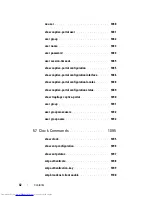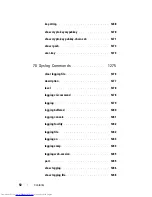
Command Groups
55
1
Command Groups
Introduction
The Command Line Interface (CLI) is a network management application
operated through an ASCII terminal without the use of a Graphic User
Interface (GUI) driven software application. By directly entering commands,
the user has greater configuration flexibility. The CLI is a basic command-line
interpreter similar to the UNIX C shell.
A switch can be configured and maintained by entering commands from the
CLI, which is based solely on textual input and output with commands being
entered by a terminal keyboard and the output displayed as text via a terminal
monitor. The CLI can be accessed from a console terminal connected to an
EIA/TIA-232 port or through a Telnet session.
This guide describes how the CLI is structured, describes the command
syntax, and describes the command functionality.
This guide also provides information for configuring the PowerConnect
switch, details the procedures, and provides configuration examples. Basic
installation configuration is described in the
User’s Guide
and must be
completed before using this document.
Command Groups
The system commands can be broken down into three sets of functional
groups, Layers 2, Layer 3, and Utility.
Table 1-1. System Command Groups
Command Group
Description
Layer 2 Commands
AAA
Configures connection security including authorization
and passwords.
ACL
Configures and displays ACL information.
Summary of Contents for PowerConnect 6224
Page 54: ...54 Contents show ip https 1369 state 1370 ...
Page 134: ...134 Command Groups ...
Page 186: ...186 Using the CLI ...
Page 216: ...216 ACL Commands ...
Page 236: ...236 Address Table Commands ...
Page 250: ...250 CDP Interoperability Commands ...
Page 256: ...256 DHCP Layer 2 Relay Commands Example console config dhcp l2relay vlan 10 340 345 ...
Page 284: ...284 Dynamic ARP Inspection Commands ...
Page 318: ...318 Ethernet Configuration Commands ...
Page 330: ...330 GVRP Commands ...
Page 344: ...344 IGMP Snooping Commands ...
Page 368: ...368 IP Addressing Commands ...
Page 378: ...378 IPv6 Access List Commands ...
Page 386: ...386 IPv6 MLD Snooping Querier Commands MLD Version Indicates the version of MLD ...
Page 393: ...LACP Commands 393 Oper Key 29 Partner System Priority 0 MAC Address 000000 000000 Oper Key 14 ...
Page 394: ...394 LACP Commands ...
Page 404: ...404 Link Dependency Commands ...
Page 432: ...432 LLDP Commands ...
Page 446: ...446 Port Monitor Commands 1 Enable 1 g10 1 g8 Rx Tx ...
Page 572: ...572 TACACS Commands ...
Page 610: ...610 VLAN Commands ...
Page 616: ...616 Voice VLAN Commands ...
Page 618: ...618 802 1x Commands 802 1x Option 81 radius server attribute 4 ...
Page 656: ...656 ARP Commands IP Address MAC Address Interface Type Age console ...
Page 822: ...822 IPv6 Routing Commands ...
Page 826: ...826 Loopback Interface Commands ...
Page 828: ...828 Multicast Commands show ip pimsm rphash show ip pimsm rp mapping ...
Page 854: ...854 Multicast Commands ...
Page 930: ...930 OSPF Commands ...
Page 933: ...OSPFv3 Commands 933 show ipv6 ospf virtual link show ipv6 ospf virtual link brief ...
Page 1004: ...1004 PIM SM Commands ...
Page 1014: ...1014 Router Discovery Protocol Commands ...
Page 1054: ...1054 Autoconfig Commands boot host dhcp boot host retry count show boot ...
Page 1058: ...1058 Autoconfig Commands ...
Page 1094: ...1094 Captive Portal Commands ...
Page 1110: ...1110 Clock Commands ...
Page 1130: ...1130 Configuration and Image File Commands ...
Page 1142: ...1142 Denial of Service Commands ...
Page 1178: ...1178 Power Over Ethernet Commands ...
Page 1220: ...1220 Serviceability Tracing Packet Commands ...
Page 1232: ...1232 Sflow Commands ...
Page 1262: ...1262 SNMP Commands ...
Page 1346: ...1346 System Management Commands 4 5 ...
Page 1350: ...1350 Telnet Server Commands ...
Page 1372: ...1372 Web Server Commands ...
















































